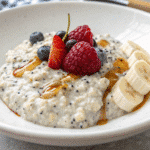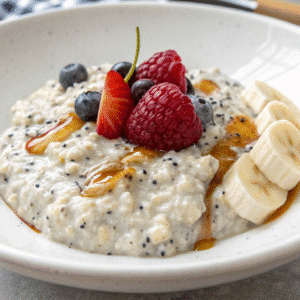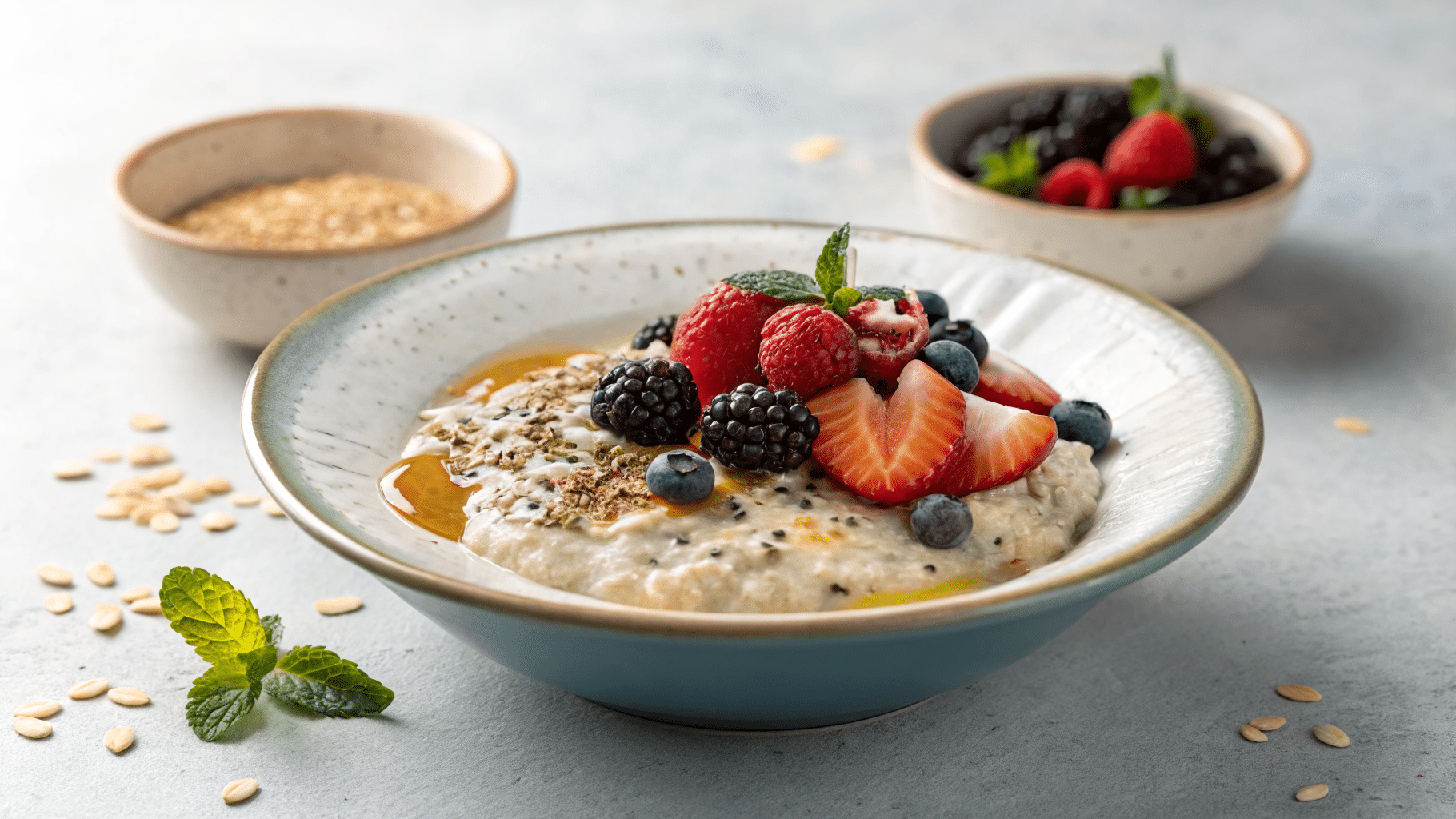
Starting your day with overnight oats gluten-free is a smart choice for anyone looking for a quick, nourishing, and satisfying breakfast. With the rise in gluten intolerance and celiac diagnoses, more people are swapping traditional oats for gluten-free versions. This article breaks down what gluten-free overnight oats are, how to make them, what ingredients to use, how they affect those with celiac disease, and tips to keep them tasty and safe. Whether you’re new to overnight oats or refining your routine, this guide has you covered.
What Are Gluten-Free Overnight Oats?
Benefits of overnight oats gluten-free
Overnight oats gluten-free are oats soaked in liquid like milk or yogurt and refrigerated overnight, creating a creamy, no-cook breakfast. These oats are not only time-saving but also safe for those avoiding gluten. Using certified gluten-free oats removes the risk of cross-contact with wheat, making it an ideal choice for celiac and gluten-sensitive eaters.
One of the top benefits of overnight oats gluten-free is the combination of convenience and nutrition. They’re high in fiber, complex carbs, and whole grains, supporting digestion and long-lasting energy. When made with protein-rich add-ins like chia seeds, nut butters, or plant-based yogurt, they offer a satisfying and balanced meal.
Another reason people choose overnight oats gluten-free is the flexibility. You can make them dairy-free, sugar-free, or vegan using the right ingredients. Whether you prefer sweet or savory flavors, the mix-and-match options are endless. Plus, it’s one of the best gluten-free breakfasts for weekly meal prep.
Do Overnight Oats Have Gluten in Them?
Are oats naturally gluten-free?
Yes, oats are naturally gluten-free. But here’s the catch: not all oats are safe for people following a strict gluten-free diet. While the grain itself doesn’t contain gluten like wheat or rye, oats are often grown, harvested, or processed alongside gluten-containing crops.
This means that your everyday store-brand oats likely contain trace amounts of gluten. So, when preparing overnight oats gluten-free, it’s crucial to use oats that are certified gluten-free. These oats are produced under special handling procedures that limit cross-contact with gluten.
Many people mistakenly think all oats are safe just because they’re not wheat-based. But for those with celiac disease or gluten sensitivity, even tiny levels of contamination can cause a reaction. This is why the label matters. Always check packaging carefully.
Risks of cross-contamination in processing
Cross-contamination occurs when oats come into contact with gluten-containing grains like wheat, barley, or rye during harvesting, transportation, or packaging. These grains may be processed using the same equipment or stored in the same silos.
That’s why certified oats for overnight oats gluten-free are either grown in controlled fields or sorted mechanically to remove foreign grains. Mechanically sorted oats are common in North America but may still have slight risks. For people with severe celiac disease, oats made using the Purity Protocol are often considered safer.
Here’s a breakdown of how common oat types compare:
| Oat Type | Gluten-Free? | Safe for Celiac? |
|---|---|---|
| Regular Oats | No | Unsafe |
| Certified GF Oats | Yes | Likely Safe |
| Purity Protocol Oats | Yes | Recommended |
Looking for more gluten-free breakfast recipes? Try our popular No-Lettuce Bean Salad that’s plant-based and fiber-rich.
How to Make Gluten-Free Overnight Oats with Yogurt
Step-by-step yogurt overnight oats gluten-free
Making overnight oats gluten-free with yogurt is quick, easy, and requires no cooking. It’s a flexible base recipe you can customize for taste, texture, and dietary needs. Whether you’re prepping one jar or a week’s worth of breakfast, the method stays the same.
Here’s a basic recipe to follow:
| Ingredient | Quantity |
|---|---|
| Certified gluten-free rolled oats | ½ cup |
| Plain yogurt (or dairy-free) | ½ cup |
| Milk (any type) | ⅓–½ cup |
| Chia seeds (optional) | 1 tbsp |
| Sweetener (honey, etc.) | 1–2 tsp |
| Fruit or toppings | ¼–½ cup |

Instructions:
- Add oats, yogurt, milk, chia seeds, and sweetener to a mason jar or container.
- Stir until fully combined.
- Add fruit (like berries or bananas) on top.
- Cover and refrigerate for 6–8 hours or overnight.
- In the morning, stir, add more milk if needed, and enjoy.
That’s all you need to prep overnight oats gluten-free in under 5 minutes. It’s a great option for families, kids, or anyone avoiding gluten.
Variations using dairy or dairy-free yogurt
The beauty of overnight oats gluten-free is how customizable they are. You can switch between dairy and dairy-free yogurt options to match your diet or taste.
Dairy Options:
- Plain Greek yogurt: thick texture and added protein
- Regular plain yogurt: creamier with more moisture
Dairy-Free Options:
- Coconut yogurt: slightly sweet and tropical
- Almond or cashew yogurt: smooth and nutty
- Soy yogurt: high protein and neutral in taste
Each yogurt type adds a slightly different consistency and flavor, but all work well in overnight oats gluten-free recipes. For an extra protein boost, some people mix protein powder directly into the yogurt before stirring in oats.
Ingredients and Substitutes for Gluten-Free Overnight Oats
Common add-ins: milk, chia seeds, fruit, sweeteners
The best thing about overnight oats gluten-free is how easy it is to customize the base with your favorite ingredients. Once you’ve got certified gluten-free oats, you can create endless combinations that suit your mood or diet goals.
Here are some common add-ins used in gluten-free overnight oats recipes:
| Ingredient | Purpose |
|---|---|
| Milk (any kind) | Softens oats and adjusts thickness |
| Yogurt (dairy or dairy-free) | Adds creaminess and protein |
| Chia seeds | Thickens texture, boosts fiber |
| Fresh or frozen fruit | Flavor, color, and natural sweetness |
| Maple syrup or honey | Adds a touch of sweetness |
| Nut butters | Protein and richness |
All of these can be adjusted by preference. Want something fruity? Add berries and bananas. Prefer something rich? Use peanut butter and dark chocolate chips. That’s the beauty of overnight oats gluten-free—every batch can taste different.
If you’re into gluten-free recipes with healthy fats and fiber, you’ll also enjoy our Vegetarian Gluten-Free Pasta Recipes for quick dinners.
Gluten-free substitutes when oats aren’t tolerated
Some people—even celiacs—struggle to digest oats, even the gluten-free kind. This is often due to avenin, a protein found in oats that can cause issues in sensitive individuals. If you’re in that group, don’t worry—there are plenty of alternatives.
You can make “overnight oats” without oats. Try these certified gluten-free grains or seeds instead:
- Quinoa flakes – light texture, high protein
- Buckwheat groats – gluten-free despite the name, earthy taste
- Chia pudding – a completely oat-free option with great texture
- Millet flakes – mildly nutty, soft texture when soaked
- Teff or amaranth – tiny grains that can be soaked and flavored
To replicate the texture of overnight oats gluten-free, you may need to adjust the liquid ratio and soak time. Some grains (like buckwheat or teff) take a bit longer to soften, while quinoa flakes are fast and fluffy.
Still craving the oat texture? Mix chia seeds and plant-based yogurt for a spoonable “mock oat” bowl. Top with fruit and nut butter for that classic overnight oat vibe—just without the oats.
Can Celiacs React to Gluten-Free Oats?
Avenin sensitivity and immune response in celiac patients
While overnight oats gluten-free are labeled safe for most people avoiding gluten, some individuals with celiac disease may still react. The issue isn’t always hidden gluten—it may be avenin, a protein naturally found in oats.
Avenin is similar in structure to gluten. Although most people with celiac disease tolerate it well, a small number may experience an immune response. Symptoms could include bloating, brain fog, or joint pain—very similar to what happens when gluten is accidentally consumed.
If you’re newly diagnosed with celiac disease, many doctors recommend avoiding oats altogether during the first 6 months. This allows the gut to fully heal before introducing overnight oats gluten-free or oat-based foods.
Research findings on safety and exceptions
Multiple studies support the safety of overnight oats gluten-free for most people with celiac disease. Clinical trials show that moderate oat consumption does not damage the small intestine in the majority of patients.
However, about 5–8% of people with celiac disease may react to oats, even when the oats are fully certified gluten-free. In these cases, doctors usually recommend permanent oat avoidance and exploring other grains.
Here’s a quick overview of current medical guidance:
| Recommendation | Details |
|---|---|
| Start oat-free | Avoid oats for 6 months post-diagnosis |
| Introduce gradually | Try ¼–½ cup certified gluten-free oats per day |
| Watch for symptoms | If symptoms return, discontinue oats |
Nutritional Advantages & Limitations of Gluten-Free Overnight Oats
High fiber, protein, and gut health benefits
Eating overnight oats gluten-free regularly offers a powerful combination of fiber, protein, and slow-burning carbohydrates. It’s a complete and satisfying breakfast that helps maintain stable blood sugar levels, promotes satiety, and supports gut health.
Gluten-free oats are packed with beta-glucan, a type of soluble fiber that helps reduce LDL (“bad”) cholesterol. When combined with chia seeds or flaxseeds, your jar of overnight oats gluten-free becomes even more gut-friendly. These ingredients feed beneficial gut bacteria, aiding digestion and immunity.
Protein can be easily added by using Greek yogurt, dairy-free alternatives with protein (like soy yogurt), or a spoon of nut butter. You can also stir in collagen powder or plant protein for an extra boost—great for those on active or high-protein diets.
If weight management is a goal, overnight oats gluten-free can be your ally. They’re filling, easy to portion, and reduce the urge to snack mid-morning.
Watch for added sugars and unbalanced ratios
While overnight oats gluten-free are healthy by design, certain versions can turn into sugar bombs—especially when loaded with sweetened yogurts, flavored milks, and syrups.
To avoid this, use plain yogurt, unsweetened milk, and limit syrup to 1–2 teaspoons. Natural sweetness from fruit (bananas, apples, or dates) is often enough. Also, don’t forget to add some protein or healthy fats like nuts, seeds, or nut butters to balance carbs and avoid energy crashes.
A typical concern is portion control. Overfilling your jar or using too many calorie-dense add-ins can turn a light meal into a 600-calorie breakfast. Stick with the base recipe, then adjust based on your needs.
Here’s a quick nutrition breakdown (approximate values for 1 serving made with unsweetened almond milk, chia seeds, and fruit):
| Nutrient | Amount |
|---|---|
| Calories | 280–320 |
| Protein | 10–15g |
| Fiber | 8–10g |
| Sugar (natural) | 7–10g |
Avoiding excess sugar is key to keeping overnight oats gluten-free healthy and effective as a daily breakfast option.
Easy Storage, Meal Prep & Shelf Life Tips for Gluten-Free Overnight Oats
How to store overnight oats gluten-free safely
Proper storage makes overnight oats gluten-free a reliable go-to for busy mornings. Because there’s no cooking involved, safe refrigeration is essential to maintain both taste and food safety.
After preparing your oats, immediately place them in the refrigerator. Use jars or containers with airtight lids to prevent contamination and moisture loss. Keep the fridge at or below 40°F (4°C) to prevent bacterial growth.
Glass mason jars are perfect. They’re leak-proof, easy to clean, and help prevent unwanted flavors from soaking into the oats. If you’re prepping several jars, label each one with the prep date to stay organized.
Never leave overnight oats gluten-free at room temperature for more than two hours. This can cause bacterial buildup, especially if made with dairy products or fruit.
How long overnight oats gluten-free last in fridge
When stored properly, overnight oats gluten-free stay fresh in the fridge for up to 5 days. This makes them ideal for Sunday meal prep and ensures breakfast is ready with no stress all week long.
The shelf life depends on what’s added. If you mix in fresh berries or bananas, consume them within 2–3 days, as soft fruits break down faster. Drier toppings like coconut, chia seeds, or frozen fruit hold up longer.
Here’s a quick storage timeline guide:
| Add-In | Best By (Fridge) |
|---|---|
| Plain oats + yogurt | 4–5 days |
| With fresh fruit | 2–3 days |
| With nut butter or frozen fruit | 4–5 days |
If you notice sour smell, slimy texture, or discoloration, it’s best to discard the jar.
You can also freeze overnight oats gluten-free in individual portions. Just leave out the fruit and yogurt before freezing. When ready, thaw in the fridge overnight and add fresh toppings before serving.
Toppings, Flavors & Customization Ideas for Gluten-Free Overnight Oats
Creative ways to flavor overnight oats gluten-free
One of the best things about overnight oats gluten-free is how easily they adapt to your taste. Whether you like things fruity, nutty, or dessert-inspired, there’s a flavor combination for you.
Use these ideas to keep things exciting all week long:
Fruit-Based Flavors
- Banana + peanut butter + cinnamon
- Berries + Greek yogurt + honey
- Apple chunks + honey + chopped pecans
- Mango + coconut milk + chia seeds
- Pineapple + banana + coconut flakes (tropical style)

Dessert-Inspired Flavors
- Chocolate chips + almond butter + vanilla
- Cocoa powder + raspberries + oat milk
- Chai spice + almond milk + golden raisins
- Pumpkin puree + nutmeg + honey
- Lemon zest + blueberries + cream cheese

Nutty & Protein-Heavy Combos
- Almond butter + chia seeds + hemp hearts
- Walnuts + dried cranberries + cinnamon
- Peanut butter + dark chocolate chips
- Cashew butter + banana slices

For a fun rotation, plan your week with a different jar each day. It’s a smart way to avoid flavor fatigue and make overnight oats gluten-free something you genuinely look forward to.
Toppings to change texture & nutrition
Toppings turn your jar of overnight oats gluten-free into a complete, satisfying meal. They add crunch, sweetness, and extra nutrients. Always add toppings right before serving to keep them fresh and crispy.
Here are great topping ideas:
| Topping | Purpose |
|---|---|
| Chopped nuts | Crunch + healthy fats |
| Granola (gluten-free) | Extra texture + flavor |
| Coconut flakes | Tropical finish |
| Seeds (chia, flax, hemp) | Fiber + omega-3s |
| Fresh fruit slices | Color + sweetness |
Play around with combinations. Some people love savory oats too—with avocado, boiled eggs, or even spinach.
FAQs
How do you make gluten-free overnight oats with yogurt?
Start with ½ cup certified gluten-free rolled oats, ½ cup yogurt (plain or dairy-free), and ½ cup milk. Add chia seeds, a touch of sweetener, and fruit. Mix well, cover, and refrigerate overnight. In the morning, your creamy, protein-rich overnight oats gluten-free are ready to enjoy.
What is a gluten-free substitute for oats in baking?
If you can’t tolerate oats, try substitutes like quinoa flakes, buckwheat groats, or millet flakes. These grains offer a similar texture and nutritional value in recipes like cookies or muffins. You can also try chia pudding or almond flour as alternatives in oat-free versions of overnight oats gluten-free.
Conclusion
Overnight oats gluten-free are more than a trend—they’re a smart, healthy breakfast solution for busy mornings and gluten-free lifestyles. With just a few base ingredients, you can prep meals that are customizable, filling, and ready when you are. Certified gluten-free oats, paired with the right mix-ins and toppings, make this recipe endlessly versatile—perfect for kids, athletes, and anyone avoiding gluten.
If you’re looking for daily recipe inspiration, weekly meal prep ideas, or fresh takes on gluten-free cooking, you’ll love our content across social platforms. Follow Easy Cooking US on Pinterest for visual recipes and meal-prep boards, check out our gluten-free guides on Medium, join the conversation on X (Twitter), or browse short-form tips and reels on Tumblr.
Your journey to stress-free, tasty, and nourishing breakfasts starts right here—with overnight oats gluten-free made just how you like them.
Meet Emily Culino
Emily Culino is a chef, food stylist, and gluten-free recipe creator dedicated to helping others eat well without compromise. After personally navigating food sensitivities, she turned her passion for real, nourishing ingredients into a platform that inspires thousands daily. Emily shares simple, flavorful recipes that fit busy lives and strict diets—without sacrificing taste or texture. Through her blog and social channels, she helps home cooks feel confident, creative, and supported in the kitchen.
Table of Contents

Overnight Oats Gluten-Free
Equipment
- mason jar or container
- spoon
- refrigerator
Ingredients
- 0.5 cup certified gluten-free rolled oats
- 0.5 cup plain yogurt (or dairy-free alternative)
- 0.33–0.5 cup milk (any type)
- 1 tbsp chia seeds (optional)
- 1–2 tsp maple syrup or honey
- 0.25–0.5 cup fruit or toppings of choice
Instructions
- In a mason jar or container, add the oats, yogurt, milk, chia seeds, and sweetener.
- Stir well until everything is fully combined.
- Top with fruit or other mix-ins like nut butter or chocolate chips.
- Cover and refrigerate for 6–8 hours or overnight.
- In the morning, stir again, add extra milk if needed, and enjoy.

